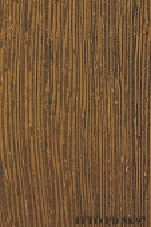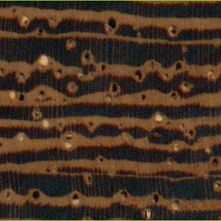
WENGé (Millettia stuhlmannii)
Trade Name
Wengé
Scientific Name
Millettia stuhlmannii Taub.
Family
LEGUMINOSAE
Common Names
Wenge (France); Panga-panga (France); Panga-panga (United Kingdom); Panga-panga (Germany); Mpande (Tanzania); Jambiré (Mozambique); Wenge
Description Of The Tree
Botanical Description
The tree reaches a height of 20 to 23 m. The bole is usually straight, unbuttressed, occasionally with heart rot shakes and pockets of ingrown bark. The trunk diameter attains 130 cm. Log is banned for international trading.(Cameroon)
Natural Habitat
Millettia stuhlmannii is found in semi-deciduous, sometimes in periodically inundated swampy forests.
Natural Distribution
Central Africa and southern regions of Tanzania, Mozambique, also in the Republic of Congo.
Wood Identification
Anatomic Description Of Wood
Wood diffuse porous. Occasionally vessels exclusively solitary (over 90%). Tangential diameter of vessel lumina 200 micras or more (large). Yellow-colored deposits in heartwood vessels. Vestured pits. Vessels per mm2 less than 6 (rare). Simple perforation plate Axial parenchyma in thick bands. Axial parenchyma storied. Two cells per parenchyma strand. Axial parenchyma bands more than 3 cells wide. 4 to 10 rays per mm (medium). Rays storied. Rays 1 to 4 seriate. Homogeneous rays and/or sub-homogeneous rays (all ray cells procumbent). Body ray cells procumbent with over 4 rows of upright and/or square marginal cells (Kribs-I). Non-septate fibers. Fibers with simple to minutely bordered pits.
-
 Wood Macro Photo Radial Plane
Wood Macro Photo Radial Plane
-
 Wood Micro Photo Of Transversal Section
Wood Micro Photo Of Transversal Section
Availability
Cites Status
Unrestricted
General Wood Description
Color
The sapwood is whitish, it has a thickness of 2 to 3 cm. The heartwood is yellowish brown toning down to purplish brown, with pink-brown thin stripes, it is clearly demarcated.
COLOR INDEX (1=Black, 7=Light yellow,white)
2
Grain
Straight; grain has no particular influence on drying, machining and finishing qualities.
Texture
The wood is reported to have a coarse texture.
Natural Durability
Very durable to decay; without preservative treatment. This species is especially suited for all the uses with risks of permanent or long-lasting humidification. Resistant to termites attack. Heartwood is resistant to Lyctus attacks.
Natural durability index (1= Very high durability, 7=Vey low durability)
1
Internal Growth Stresses
For this species no growth stresses are reported.
Resistance To Impregnation
Nearly impossible to treat with a too much low penetration of the preservative substances.
Wood Physical Properties
Drying Defects
Ease of Drying: Drying is moderately easy; some particular care is needed. Drying Defects: Risks of checks. Kiln Schedules: Schedule proposed as a reference by comparison with well known species taking into account to the general technological behavior of this species.
Recommended Dry Kiln Schedule
FR-13
Wood Chemical Properties
Wood Mechanical Properties
Workability
Sawing
Sawing of this species requires powerful equipment.
Rotary Veneer Cutting
Suitable for slicing.
Sliced Veneer
Suitable for slicing.
Blunting Effect
Moderate blunting effect; stellited blades for sawing and carbide tools for machining are advised.
Machining
It needs powerful tools for processing. Possible difficulties caused by interlocked grain are reported.
Planing
Rather difficult; special tools are needed.
Moulding
Moderately easy; tools must be cautiously sharpened.
Turning
30
Boring
Moderately easy; tools must be cautiously sharpened.
Mortising
Moderately easy; tools must be cautiously sharpened.
Nailing
Pre-boring is necessary.
Gluing
Difficult to glue because of high density.
Sanding
Easy to perform; it gives good results.
Polishing
Needs pre-coating.
Response To Hand Tools
Working with hand tools is difficult.
REFERENCED USES
End Uses Summary
HOUSING GENERAL, boards, flooring, parquet, frames, steps, panelling, fittings, FURNITURE AND CABINETS, luxury furniture, cabinets, PLYWOOD AND VENEER, Decorative veneer, TURNING, ornaments, turned furniture, cutlery, lasts, OTHER AND MUSICAL INSTRUMENTS, handicrafts
General Housing
- 10 - Silica in Timbers
Boards
- 13 - Dry kiln schedules for commercial woods. Temperate and tropical. Section III. Latin American (Mexico, Central, and South America) Woods–Conventional Temperatures
Flooring
- 14 - Handbook of Hardwoods
Parquet
- 15 - Empire Timbers
Frames
- 16 - Woods of the World
Steps
- 17 - Tree Conservation Database
Paneling
- 18 - W3TROPICOS Missouri Botanical Garden
Fittings
- 19 - Silica in Timbers
Furniture Cabinets
- 21 - Tropical timbers of the world. Part III-Southeast Asian and Oceanian Species.
Furniture, Luxury
- 22 - Dry kiln schedules for commercial woods. Temperate and tropical. Section IV-Asian and Oceanian Woods
Cabinet
- 24 - Empire Timbers
Panels, Veneers
- 25 - Directory of Timber Trade Malaysia
Decorative veneer
- 28 - Ministry of Agriculture, Fisheries & Forest of Fiji
Turning
- 30 - Embassy of Honduras in Japan
Ornaments
- 31 - Embassy of Colombia in Japan
Turned Articles
- 32 - Embassy of Cote d`Ivoire in Japan
Knife Handles
- 33 - Embassy of Gabon in Japan
Lasts
- 34 - Embassy of Indonesia in Japan
Handcraft
- 66 - Maderas latinoamericanas. VII. Caracteristicas anatomicas. propiedades fisicomecanicas, de secado, y tratabilidad de la madera juvenil de Cordia alliodora (Ruiz & Pav. Oken.)
Please Provide Information To View Producer Information